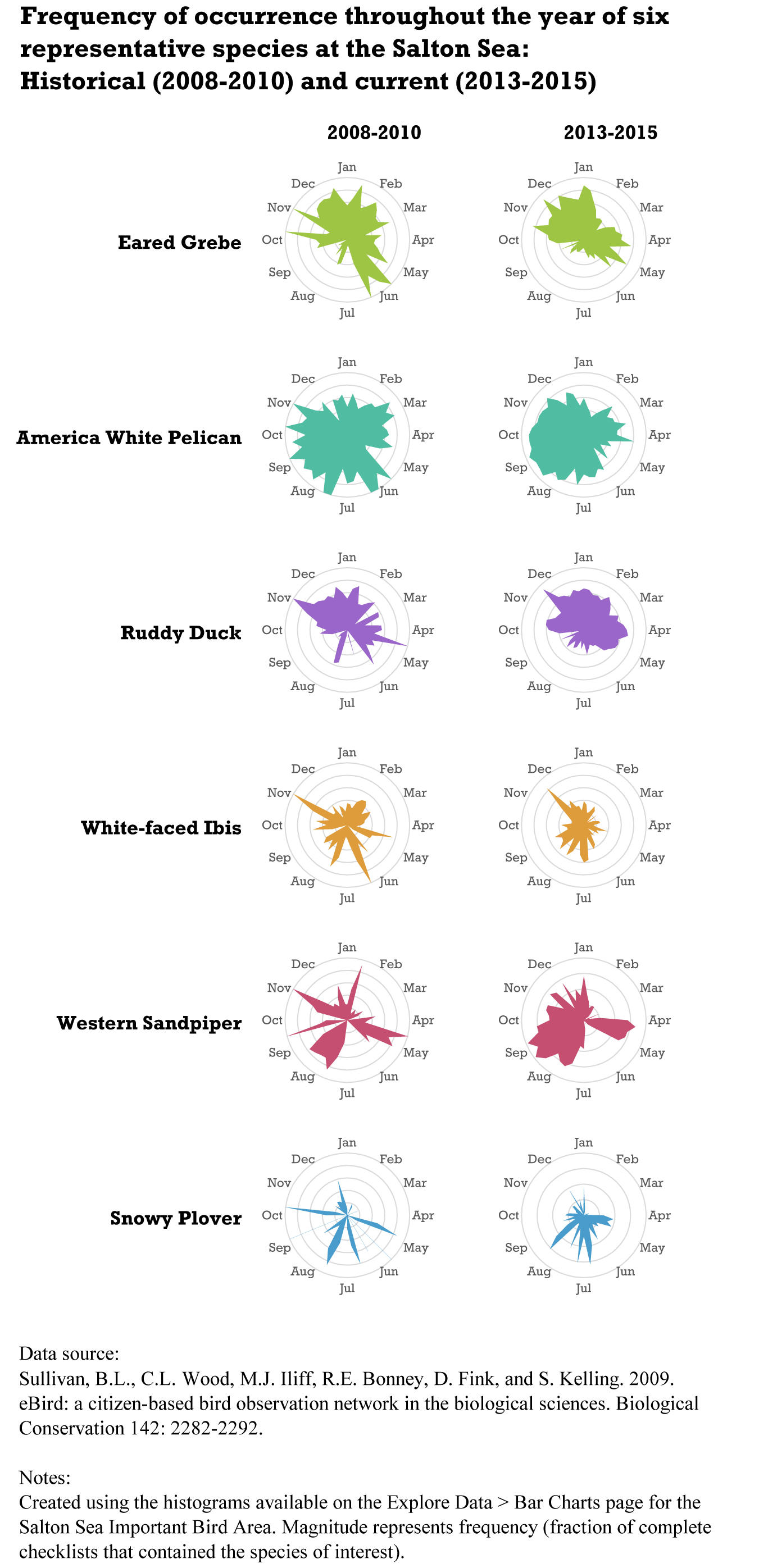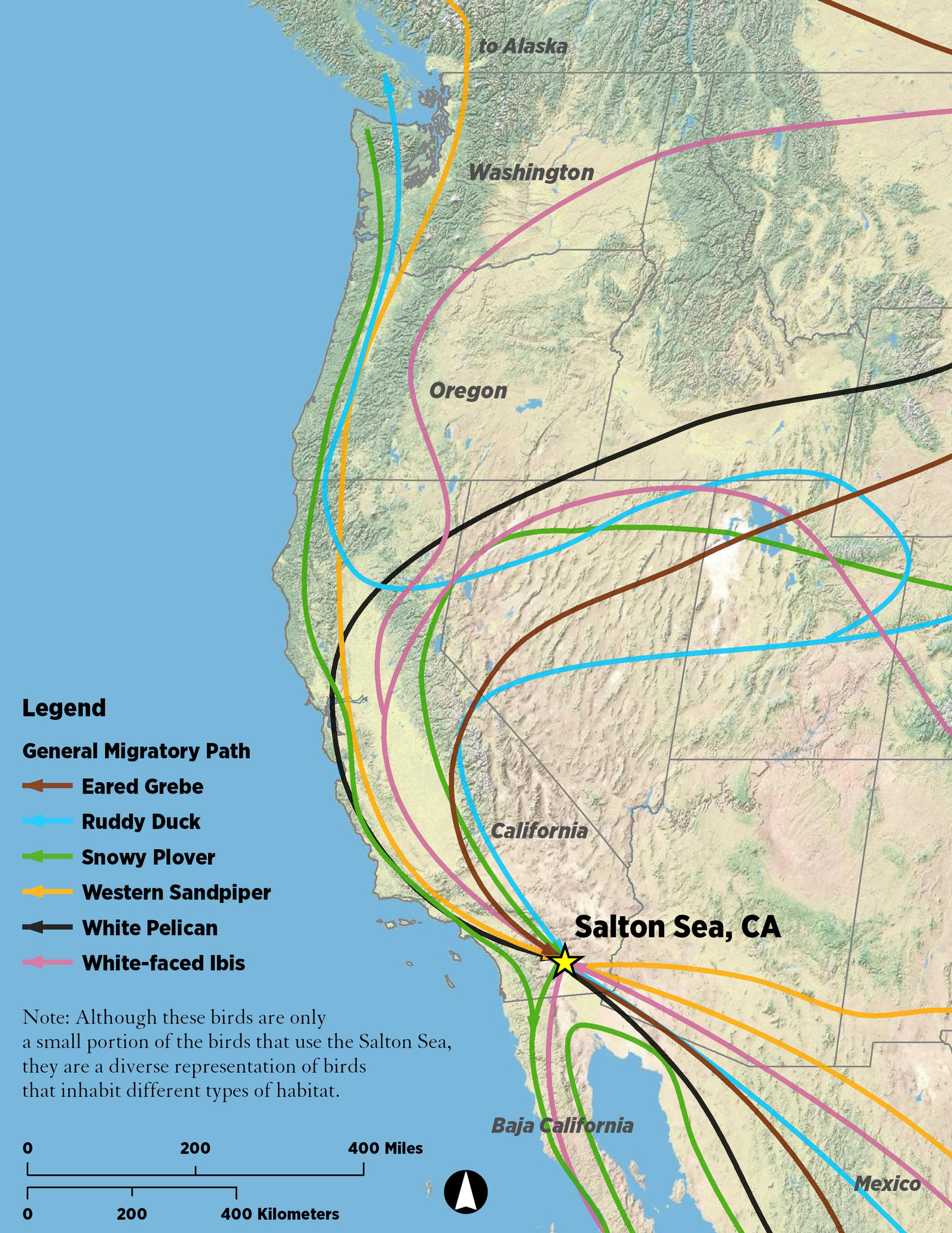Sustaining the Salton Sea is critical for millions of migratory birds and the health of 650,000 regional residents.
Frank Ruiz, Director of Salton Sea Programs with Audubon California, looks out at the Salton Sea
The Salton Sea is one of the most important places for birds in North America, but is at risk of losing its ecological value. As the Sea changes, we face unclear impacts on a vital part of the Pacific Flyway and the growing possibility of a toxic dust bowl that will threaten public health for more than a million Californians.
As part of the Colorado River Delta, the sea filled and dried for thousands of years prior to its current, 35-mile-long incarnation, which came into existence as the result of a massive flood of the Colorado River in 1905. The 330-square-mile Sea has partially replaced wetland habitat lost to agricultural and urban conversion in the Colorado River Delta, California’s coast, and the San Joaquin Valley.
The Sea is a globally significant Important Bird Area (IBA). For the past century, the Sea has served as a major nesting, wintering, and stopover site for millions of birds of approximately 400 species. Until recent years, tiny Eared Grebes wintered by the thousands in rafts far out on its surface. American White Pelicans roosted on mudflats and fished for tilapia in its shallows. Migratory shorebirds stopped to migrate and feed along the Sea’s edge. Today’s avifauna is shifting – the Sea is losing the fish-eating birds such as pelicans and cormorants because fish populations are disappearing. Eared Grebes, who have fed on pile worms, are also declining rapidly, from millions to several thousand. Shorebirds, however, that feast on invertebrates along the shore edges, as well as shallow feeding ducks such as Northern Shoveler and Ruddy Duck, are still wintering at, or passing along the Sea, in massive numbers.
Recently, its water level dropped to the point that colonial seabirds began abandoning nesting sites en masse in 2013, and shallow, marshy habitat areas at the sea’s edge have begun to rapidly vanish, particularly at the south end. In 2017, inputs of Colorado River water were transferred from local agricultural uses to urban uses on the coast. As less water flowed into the Sea, it shrunk considerably, becoming more saline and inhospitable to birds, fish, and insects.
We must take immediate action at the Salton Sea to protect human health and establish viable habitat for millions of migratory birds.
Conservation investments at the Salton Sea must embrace a holistic approach, considering the well-being of all waterbirds, including shorebirds.
Conducting community science during a glorious spring migration for the Intermountain West Shorebird Survey
Our latest study shows how biofilm may be providing the biofuel that migratory shorebirds need
Discover the data and resources about the habitats and changes happening at the Salton Sea from across the network.
Cómo un humedal emergente en la Laguna Salton Sea ofrece nuevas esperanzas para las aves migratorias y las comunidades locales.
Audubon California has begun the planning phase for the restoration and enhancement of the newly emerging Bombay Beach Wetland, located by the town of Bombay Beach at the Salton Sea.
Our new, downloadable pocket field guide features some birds of the Coachella Valley that are culturally significant to the Cahuilla people of the Torres-Martinez Band.
Estamos estrenando nuestra nueva, descargable guía de campo de algunas aves del Valle de Coachella, las cuales son culturalmente importante para los Cahuilla.
More than 400 species of birds come to the Salton Sea in California.
News emerged in late April of ongoing negotiations among representatives of California, Nevada, and Arizona about the use of water from the Colorado River, which is on the verge of a major shortage. While details of the negotiations aren't clear, the goal has been to keep more water in Lake Mead to stave off a declaration of a shortage.
We wanted to see a graphic representation of when certain birds appear at the Salton Sea. Violà.


The Salton Sea is one of the most important migratory stops along the Pacific Flyway. But it’s hard to understand what this means without seeing it visually. So we took a sample of birds and tracked their migratory pathways through California – note the one thing they all have in common. And this is just a handful of the 400 species that make regular use of the Salton Sea.
A few more things to consider:
About a week ago, Audubon California's staff and board visited the Salton Sea to see California's largest lake firsthand -- to see the birds and learn more about the many conservation challenges facing this vital stop on the Pacific Flyway. We grabbed a little video while we were there.
Our newsletter is fun way to get our latest stories and important conservation updates from across the state.
Help secure the future for birds at risk from climate change, habitat loss and other threats. Your support will power our science, education, advocacy and on-the-ground conservation efforts.
Join the thousands of Californians that support the proposed Chuckwalla National Monument.